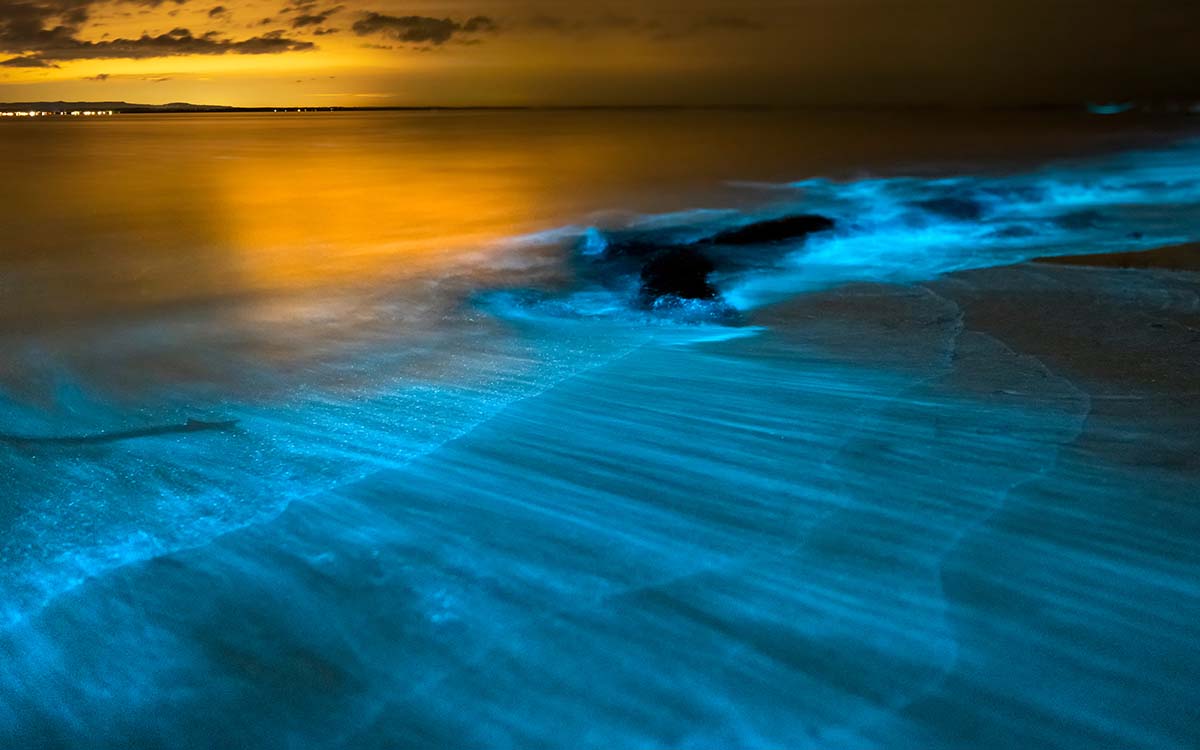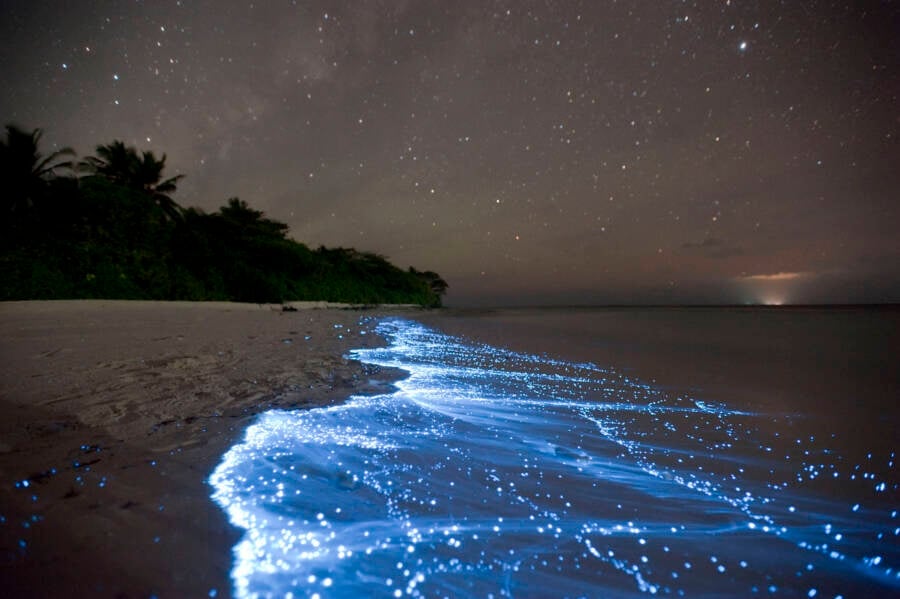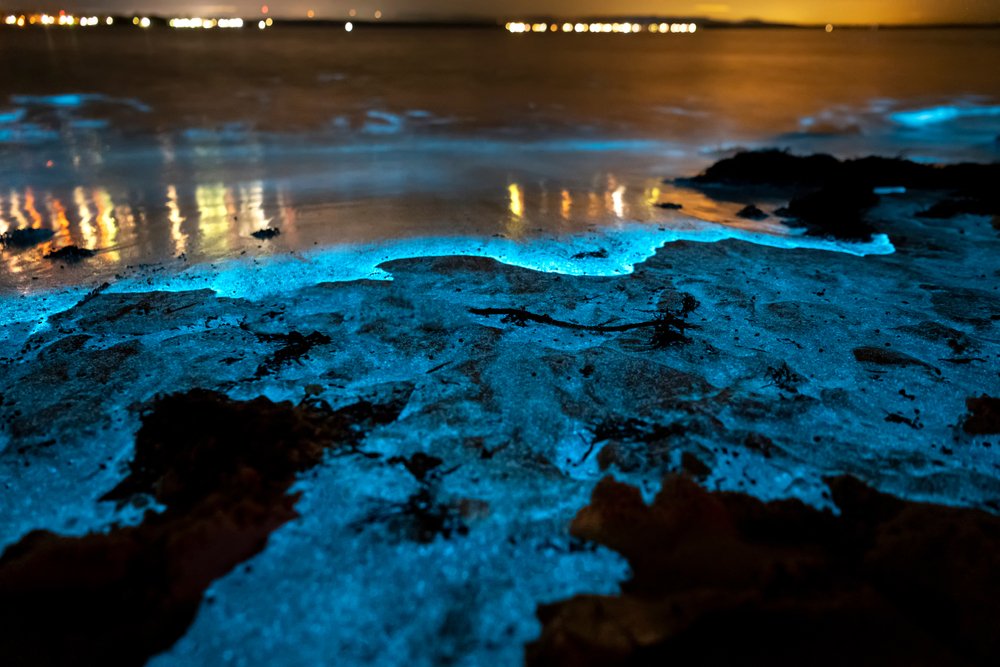Estimated reading time: 7 minutes

People often escape to the beach to revel in its breathtaking landscape and scenic views. A stroll along the sandy shore as “golden hour” approaches offers spectators a remarkable show of colors as the sun sets beyond the horizon. As darkness begins to set in, the sound of the crashing waves becomes more prominent, and the stars above illuminate the night sky. Beach lovers and nature enthusiasts are all too familiar with these scenes. But did you know that the ocean can also illuminate? The next time you’re stargazing at the beach, be sure to look down. If you’re lucky, you might experience this natural phenomenon called bioluminescence.
What is Bioluminescence?

Bioluminescence is the emission of light by living organisms, such as a firefly, through a natural chemical process called chemiluminescence. While bioluminescence occurs in various organisms, including fungi and bacteria, when it comes to bioluminescent oceans and bays, it is usually produced by an algae bloom, casting a blue or sometimes green glow in the water. However, bioluminescent jellyfish and squid can also illuminate coastal waters.
If you’re intrigued by this phenomenon, your next questions could be: when and where could I see this in person? Bioluminescence season could start as early as May or June in the northern hemisphere. Still, peak season typically runs from July through September when the waters are warm, allowing for optimal conditions for algae growth. During these months, many beach areas and cities offer promotions and tours for tourists and visitors to experience this natural wonder. Ready to explore the glowing waters first-hand? Here is our list of top bioluminescent beaches and bays around the world.
Mosquito Bay, Puerto Rico

From weather conditions to water temperature, many factors contribute to optimal viewing opportunities of bioluminescence. And if you’re looking to visit a locale with the highest chance of experiencing this phenomenon, look no further than Puerto Rico’s Mosquito Bay. What makes Mosquito Bay so special is its high concentration of Pyrodinium bahamense. Because of this, spectators will also experience the brightest illumination of bioluminescence in the world. Here are some other facts about Mosquito Bay:
- It was named after a pirate ship, El Mosquito and not because the area is infested with mosquitoes.
- The bay received the title of Brightest Bioluminescent Bay in the World by the Guinness Book of World Records.
- No swimming allowed. Oils from human skin and hair, along with lotions, perfumes, sunscreens, and other chemicals, have contributed to the decline of Pyrodinium bahamense. Therefore, swimming is banned.
- The bay is located on an island called Vieques. To get there, you can take a flight from San Juan or a ferry from Ceiba.
Toyama Bay, Japan

Visible for a few months during April through June, the bioluminescence of the firefly squid is unarguably one of the most spectacular light displays nature has to offer. Toyama Bay, located off the city of Toyama in the Sea of Japan, is the only place where firefly squids rise to the water’s surface to spawn. During this time, tourists can see these illuminated creatures come together in large numbers, putting on a stunning show of blue bioluminescence. Here are some interesting facts about Toyama Bay:
- Boat tours are available to view firefly squid bioluminescence. Tours typically begin around 2 a.m.
- Firefly squid are only 3 inches long but are described as a meatier and more affordable squid variety.
- Firefly squid sightseeing became part of Toyama’s tourist industry in 1912.
- The Museum of Firefly Squid, the only firefly squid museum, was established in 1998.
Vaadhoo Island, Maldives

Unlike bays and coves where bioluminescent phytoplankton collectively gather, the bioluminescence phenomenon on Vaadhoo Island, known as the Sea of Stars, is harder to locate. Because plankton float freely in the ocean, bioluminescence could occur anywhere along its coastline where the conditions are optimal for algae bloom. Nevertheless, when it does happen, the beauty of its electric blue glow radiating along the shoreline is undeniable. The Sea of Stars is one of Vaadhoo Island’s top tourist attractions. Here are some interesting facts about Vaadhoo Island:
- The small Vaadhoo Island is part of the island chain nation of Maldives in the Indian Ocean.
- Its population is approximately 500.
- The island is known for its pristine white sand beaches and luxury resorts.
- Flights are available to the Male International Airport in the capital city of Maldives. From there, you can charter a boat to Vaadhoo Island.
Indian River Lagoon, Florida (United States)

Located on the Atlantic Coast of Florida, The Indian River Lagoon is an estuary with a mix of salt water from the sea and freshwater from the Indian River. Unique from previous destinations mentioned, the Indian River Lagoon hosts two types of bioluminescent organisms: phytoplankton and comb jellies. Unlike other jellyfish varieties, comb jellies (Ctenophora) do not sting; when disturbed, they emit a beautiful glow, adding to the allure of the region’s bioluminescent sightseeing experience. Here are some interesting facts about the Indian River Lagoon:
- The Indian River Lagoon is the most bio-diverse estuary in North America.
- It is 156 miles long and comprises the Mosquito Lagoon, the Banana River, and the Indian River, encompassing 40% of Florida’s eastern coast.
- The best place to experience bioluminescence in the Indian River Lagoon is near Cocoa Beach.
Jervis Bay, New South Wales (Australia)

On the other end of the globe, a popular destination for experiencing beach bioluminescence in the southern hemisphere is Jervis Bay. Located on the South Coast of New South Wales, several beaches have reports of bioluminescent activity. Bioluminescence from phytoplankton can be fleeting, often requiring optimal conditions such as water temperature, light pollution, and other factors. However, November through March are the best months for catching a glimpse of the illuminated blue waters at this location. Here are some interesting facts about Jervis Bay:
- Jervis Bay is known for its white sand beaches and turquoise blue waters.
- Top beaches at Jervis Bay with bioluminescence are Barfluer Beach, Hyams Beach, Callala Beach, and Blenheim Beach.
- Jervis Bay is an approximate 2.5-hour drive from Sydney.
- Although bioluminescence is a popular tourist attraction, other activities include whale watching, dolphin cruises, and scuba diving.
Experiencing bioluminescence at the beach is often unpredictable, with many contributing factors to its illumination. But if you’re interested in tracking down this natural wonder, these locations offer the best chances for a successful viewing.
Want to delve deeper into the beach lifestyle? Check out our other articles on Beach Homes Lifestyles.

